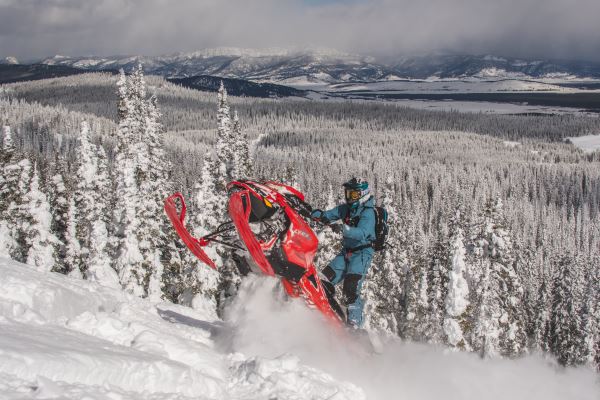 Have you played the psychological game where someone shows you a photo and you have to quickly say the first thing that pops into your mind? Well the editors of SnoWest took our first impressions of five significant features of the Lynx BoonDocker DS 3900 and the results were interesting.
Have you played the psychological game where someone shows you a photo and you have to quickly say the first thing that pops into your mind? Well the editors of SnoWest took our first impressions of five significant features of the Lynx BoonDocker DS 3900 and the results were interesting.
Lynx is a Scandinavian snowmobile that has been imported to the North American market for the 2022 model season, although it was only made available via “spring only” orders. So you likely won’t see them saturating the backcountry any time soon. But you will start to see them … and for a very good reason: they are uniquely designed and will shine in certain kinds of western riding areas.
So let’s start our word-association game. (You can play at home if you like.)
1—Engine
Proven. Since Lynx is owned by BRP, and Rotax is owned by BRP, it’s only natural that the Boondocker would have the strongest, most reliable powerplant produced by BRP. The 850 E-Tec is the same liquid-cooled 849cc two-stroke found in the performance line of Ski-Doo models and delivers 165 horsepower. So the BoonDocker has the same engine, same bore & stroke, same electronic direct injection carburetion as found on the Summit models. And it comes with the SHOT starter.
The BoonDocker also has the same pDrive with clickers drive clutch and QRS driven clutch as found on the Summits, so the drivetrain will be the same bullet-proof system on the Lynx as on the Summits. You get the same explosive throttle response and power that just doesn’t seem to top out.
2—Tunnel
Beefed up and shortened. Although at first glance the BoonDocker chassis is very similar to the Summit, the Radien DS tunnel (particularly the rear end) has its own unique appearance. Perhaps it’s because the Scandinavian snowmobiler has to do a lot of log jumping and got tired of having the rear end either hang up or get bent.
There is a lot of track extending beyond the end of the tunnel so you can be sure that it isn’t going to create drag when powering through deep snow or clinging to steep slopes. By the way, the “3900” on the title represents millimeters and translates to English as a 154-inch track.
3—Snow Flap
Goofy. Because the tunnel is so short and the track so long, there is no real effective location to mount a snow flap on it. Note: The snow flap isn’t actually designed to protect the riders following you down the trail. It’s designed to re-circulate snow back to the heat extruders that are located in the tunnel.
Lynx engineers figured out a rear axle mount that served to re-direct the snow coming off the track and carom it back under the tunnel. (It also does a pretty good job of protecting the rider behind you from betting pelted with huge chunks of snow.)
4—Rear Skid
Clean. When you first look under the sled, all you see is open space, like something is missing. The BoonDocker features the PPS2 DS+ rear suspension. We have no idea what acronym comes from those numbers and letters but we’re pretty sure it has something to do with how the rear shock has been lengthened and lifted up and the rear scissor has been totally redesigned.
Link engineers have centered the weight mass and placed the bulk of the suspension directly under the rider, making the BoonDocker better balanced and easy to lift the front end up and over obstacles. You still have the Camoplast 2.5-inch PowderMax Light FlexEdge track as found on the Summit models. So you know this suspension is going to hook up hard and pop up on top of the snow.
5—Skis
Not sure. The jury is still out until we spend a lot more time on them. The Blade DS+ is a deep snow ski that reminds us of the C&A Pro ski. They appear bulky but tend to absorb some of the initial shock from those annoying deep moguls found on seldom-maintained backcountry trails.
These skis are slightly longer and wider to deliver a bit better flotation, allowing the BoonDocker to ride a little higher in the snow. They do a great job at holding a line on a sidehill. But time will tell how well they work in all types of snow conditions.
Other Features
Because of the limited time we’ve had on the BoonDocker, many questions remain. Initially, we thought the Lynx would be just a red version of the Ski-Doo. The front end looked very similar to the Ski-Doo’s RAS 3, even though Lynx calls it the LFS. Lynx also uses high performance KYB Kashima shocks on front and rear.
Some of the subtle differences between the BoonDocker and the Summit are found on the overall dimensions. The BoonDocker is about three inches longer, one inch wider and one inch shorter. It has a 36-inch ski stance where the Summits can range from 34 to 38 inches.
Although the BoonDocker has a seat that is very similar to the Summit seat, it is slightly lower and narrower, making the Lynx a little easier to straddle and move from side to side.
Lynx also uses the LinQ accessory system, which provides more than 200 configuration options when it comes to storage.
It’s been said that you can never make a second first impression. But with the Lynx BoonDocker DS 3900, we tend to believe it will continue to impress snowmobilers in the North American market for years to come.